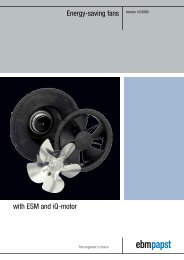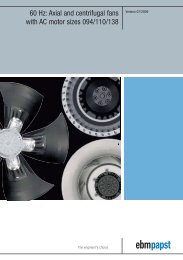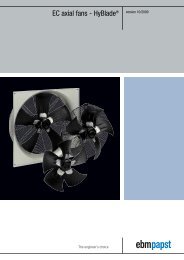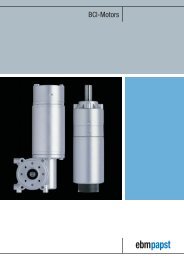Compact fans for AC and DC [PDF] - ebm-papst
Compact fans for AC and DC [PDF] - ebm-papst
Compact fans for AC and DC [PDF] - ebm-papst
- No tags were found...
You also want an ePaper? Increase the reach of your titles
YUMPU automatically turns print PDFs into web optimized ePapers that Google loves.
<strong>DC</strong> <strong>fans</strong> - specialsTechnical in<strong>for</strong>mationCooling capacity <strong>and</strong> efficiencyGreater power density, increasing miniaturisation <strong>and</strong> extreme electroniccomponent density are posing increased dem<strong>and</strong>s on the cooling capacity<strong>and</strong> efficiency of <strong>fans</strong>. The intelligent <strong>and</strong> space-saving integration of thefan in the device configuration is there<strong>for</strong>e of major importance:• Tailor-made cooling adapted to the situation as <strong>and</strong> when required.• Programmable cooling by defining speed profiles.• Transparency of function thanks to complete, interactive monitoring inall operating conditions.<strong>ebm</strong>-<strong>papst</strong> provides intelligent cooling concepts which are optimallyadapted to requirements. For example:1. Speed adaptation via NTC sensorSt<strong>and</strong>ard <strong>fans</strong> in electronics cooling– tried <strong>and</strong> tested by the millions <strong>and</strong>nevertheless a temporary solution, because st<strong>and</strong>ard <strong>fans</strong> have a distinctdisadvantage: With constant speed <strong>and</strong> a corresponding high noise factor,they continuously provide the air flow required in extreme cases. Thisextreme case only occurs-, if it occurs at all-, <strong>for</strong> a fraction of the servicelife. What is needed is an intelligent fan that automatically adapts to thecurrent cooling requirements.The <strong>ebm</strong>-<strong>papst</strong> answer: A complete range of <strong>DC</strong><strong>fans</strong> with temperature-controlled speed adaptation- in all st<strong>and</strong>ard dimensions.Installation is simple. The control electronicsreceive their thermal in<strong>for</strong>mation <strong>for</strong> speedadaptation steplessly <strong>and</strong> loss-free via a temperaturesensor either externally via a singlelead, positioned as required, or internally directlyin the fan hub in the air flow.2. <strong>DC</strong> <strong>fans</strong> with separate control inputOpen or closed-loop speed control is also possiblewith <strong>DC</strong> <strong>fans</strong> that have a separate controlinput. A variation in speed can thus be implementedvia a control voltage or a pulse-widthmodulated signal. These possibilities are usedprimarily in devices that have appropriate st<strong>and</strong>ardinterfaces <strong>and</strong> thus require a load-dependentvariation of the <strong>fans</strong>.108


![Compact fans for AC and DC [PDF] - ebm-papst](https://img.yumpu.com/48610592/108/500x640/compact-fans-for-ac-and-dc-pdf-ebm-papst.jpg)


![Download [PDF] 9.8 MB - ebm-papst Automotive & Drives](https://img.yumpu.com/47171334/1/184x260/download-pdf-98-mb-ebm-papst-automotive-drives.jpg?quality=85)

![Download [PDF] 3.1 MB - ebm-papst UK](https://img.yumpu.com/40847594/1/185x260/download-pdf-31-mb-ebm-papst-uk.jpg?quality=85)

![Download [PDF] 2.1 MB - ebm-papst UK](https://img.yumpu.com/36174834/1/190x247/download-pdf-21-mb-ebm-papst-uk.jpg?quality=85)
![Download [PDF] 2.3 MB - ebm-papst UK](https://img.yumpu.com/35271378/1/190x252/download-pdf-23-mb-ebm-papst-uk.jpg?quality=85)
![Download [PDF] - ebm-papst UK](https://img.yumpu.com/35139755/1/190x135/download-pdf-ebm-papst-uk.jpg?quality=85)

![Download [PDF] 1.5 MB - ebm-papst UK](https://img.yumpu.com/30021941/1/184x260/download-pdf-15-mb-ebm-papst-uk.jpg?quality=85)
![DC fans - specials [PDF] 1.2 MB](https://img.yumpu.com/28121898/1/184x260/dc-fans-specials-pdf-12-mb.jpg?quality=85)
